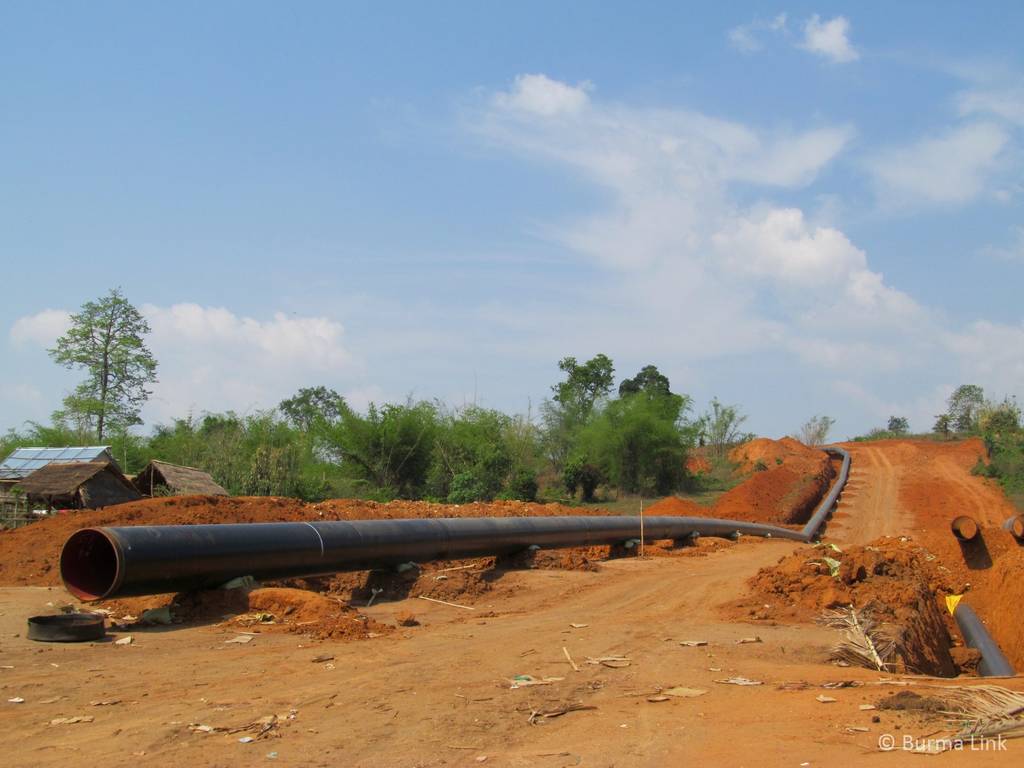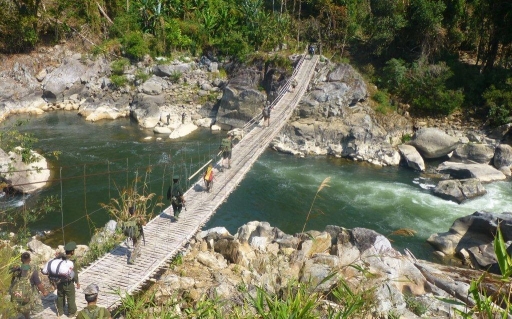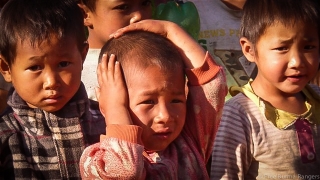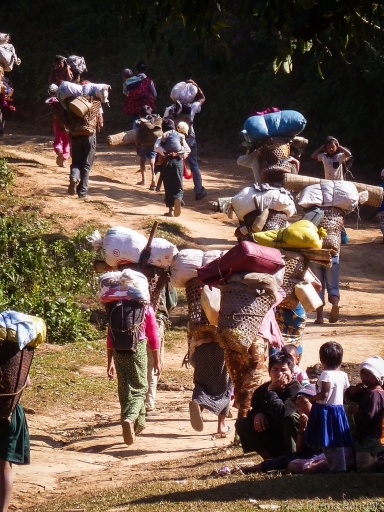Although most Kachin people live in the Kachin State, there are also some Kachin populations in China and India. While there are no reliable statistics on the Kachin population, estimates suggest there are over 1 million. The present day Kachin people consist of various ethnic subgroups, such as Jinghpaw, Lachik, Lhao Vo, Lisu, Rawang, and Zaiwa (Thein Lwin, 2011). Different ethnic sub-groups have different dances, costumes, and dialects. The Jinghpaw language is commonly used as the language of education and communication between Kachin subgroups.
All the different Kachin subgroups share the tradition of the Manau Festival, which originated from spirit worship in the past. According to Kachin National Organization’s (KNO) website (see Kachin Culture), the Manau dance involves ‘men looking warrior-like with their swords held in front’ while ‘women wear captivating and varied colourful national costumes’. The Manau festival plays an important part in the Kachin culture, with ten kinds of Manau festivals held in commemoration of special events such as successful harvests. Five of these festivals are considered to be of great significance.
The Kachin describe themselves as a nature-loving people. The Kachin State is rich in natural resources, such as jades, gold and teak, and the land is covered with undisturbed natural forests. As a result of the state’s rich resources, both legal and illegal resource extraction has, regrettably, become commonplace. While most Kachin work in agriculture, many are struggling with low income generation levels and land ownership issues. Local farmers complain that companies buy land of the government without consulting or notifying local farmers (Centre for Peace and Conflict Studies, 2010).
Another significant problem in the Kachin State is the widespread cultivation of opium and the following drug abuse that has become a serious issue particularly among Kachin youth. The largest proportional increase in opium cultivation in Burma in 2011 was observed in the Kachin State (27%; UNODC, 2011). UNODC was unable to collect on-ground survey data from Kachin State in 2012 and 2013 due to the armed conflict, which is why recent data is not reliable (UNODC, 2013). A recent Kachin report, however, exposes how anti-insurgency strategies of the Burma Army are fuelling the drug crisis in Kachin areas (KWAT, 2014a).
Other significant issues of concern in the state include an HIV/AIDS epidemic as well as the deterioration of the health and education systems ever since the government took over their development in the 1970s. Due to economic hardship and constant fear of human rights violations, many young Kachin women have been driven into the sex trade inside Burma as well as been trafficked into neighbouring China (Mizzima, August, 2008).
Although estimates vary widely, it seems safe to say that over 75% of the Kachin have been converted to Christianity, and that today the Kachin are one of the largest Christian minorities in Burma. Some Kachin people go as far as to estimate that as much as 97% of them are Christians. According to most estimates around 10% of the Kachin follow Buddhist practices while some spirit worship still continues in the hills. Local Christian communities have reported pressures to convert to Buddhism, including exemption from forced labour and free schooling for those that send their children to Buddhist monasteries (Ekeh & Smith, 2007).
The simultaneous arrival of Western missionaries and the introduction of written language, schools and health care boosted national awareness among the Kachin, who formed one of the main centres of anti-Japanese resistance during WWII. Although the Kachin initially put up fierce resistance to the British annexation, they subsequently came to form the backbone of the British army together with the Karen, Karenni, and Chin.
While the Kachin were given their own state under the 1947 Constitution, the Kachin have determinedly pursued the dream of creating a federal or independent nation state since Burma gained independence in 1948 (see Smith, 1994). The armed nationalist movement started gathering momentum in the 1960s, first due to frustration at the neglect of the Kachin region as well as the realisation that the promises made under the Panglong Agreement were not to be honoured.
Kachin Independence Organisation (KIO) and its armed wing Kachin Independence Army (KIA) were formed in 1961 and KIA quickly grew into one of Burma’s most formidable insurgency armies. KIA took up arms against the Burmese military government in 1961 in response to what many saw as growing subjugation by the Burman political establishment. The conflict further escalated when U Nu imposed Buddhism as Burma’s official state religion (for information on the history of Kachin struggle, see Human Rights Watch, 2012c; Smith, 1994).
Kachin State has been a fierce battleground since the founding of the KIO/KIA in 1961, with periods of armed conflict among several armed groups. During the 1960s, the KIA was fighting both the Burmese army and the China-backed Communist Party of Burma (CPB). After a ceasefire between the KIA and the CPB in 1976, the two groups joined forces against the Burmese army, and the CPB became a ready source of weapons and ammunition for the KIA from China. Towards the end of the 1970s KIO began working closely with other ethnic opposition groups and became the voice of National Democratic Force (NDF).
When the CPB disbanded in 1989, KIA lost their principal weapons provider at the time, and KIO and Burmese army subsequently negotiated a formal ceasefire in 1993 and 1994, granting the KIO political autonomy over a special region in Kachin State (Human Rights Watch, 2012c). The agreement also called for a range of political, economic, and legal ties between the Burmese and Kachin authorities, including a dramatic increase in the exploitation of natural resources, as well as enabling some humanitarian assistance and development in the area. Nevertheless, development in the Kachin State remained negligible for many years to come. The 1994 ceasefire agreement was not a peace agreement, and according to Human Rights Watch (2012c) did not put an end to human rights abuses by either party; KIA continued to recruit and use child soldiers, and the Burmese army continued to use forced labour and confiscate land. In 1999, Kachin National Organization (KNO) was founded with an aim to restore a genuine Federal Union in Burma.
The Kachin nationalist movement has managed to create a strong political identity among the different subgroups of Kachin that inhabit the region (Smith, 1994). KIA is Burma’s second largest non-state ethnic armed group (Human Rights Watch, 2012c), and KIO maintains a civilian administration that still governs considerable amount of territory. KIO also acts as a parallel state with departments of health, education, justice, and relief and development, among other civic programs. Jinghpaw is the official language in the KIO controlled areas and is taught at schools run by KIO. The Kachin living outside the KIO controlled areas learn the Kachin languages at Christian churches in their region. KIO has managed to build an extensive health and education system in the northern part of the state. Due to the recently ignited conflict, however, the situation in the state has deteriorated significantly.
In 2008, the Burmese government announced that all armed groups under ceasefire agreements would have to transform into a Border Guard Force (BGF) under the direct control of the Burmese army. The KIO rejected the proposal, stating that it would not transform itself into a BGF without a political solution to the underlying causes of the ethnic conflict. A 17-year ceasefire agreement between the KIA and the Burmese army fell apart on June 9, 2011, when the Burmese army attacked a strategic KIA post and began a major military offensive in Kachin State (Blythe & Hkawn Nu, 2012). In the ensuing months, the KIO lost control of a significant amount of territory that it had previously controlled and administered.
In an open letter directed to Daw Aung San Suu Kyi in September 2012, 23 Kachin organisations around the world expressed their deep concerns over the situation in the state (see U.S. Campaign for Burma, 2012b). According to the signatories:
“The Burmese army has not only launched full-scale war against the Kachin Independence Army (KIA) but also committed genocide and other heinous human rights violations deliberately attacking innocent civilians”.
The signatories listed human rights abuses committed by the Burmese army against Kachin people including rape and gang-rape against women and even children, the elderly and disabled; killing many victims of sexual violence; arbitrary executions; torture; mutilations; beatings; forced labour; mortar bombing and burning of villages; looting of villages and other thefts; and use of child soldiers, many of which constitute war crimes and crimes against humanity (U.S. Campaign for Burma, 2012b). In December 2012, the UN estimated that 75,000 Kachin people had been internally displaced in (UN OCHA, 2012). More recent estimates suggest that figure to be over 100,000 (Fortify Rights, 2014a).
The conflict escalated further in December and January when the government forces began employing airstrikes that devastated many villages in the Kachin State (FBR, 2012, 2013a). In January 2013, Free Burma Rangers (FBR) reported that fighting between the Burmese army and the KIA was taking place in every district within Kachin State, with the heaviest fighting concentrated in and around the city of Laiza (FBR, 2013a). The Burma army has reportedly been strengthening its positions, built more camps, and crept closer to Kachin positions and communities (FBR, 2013b). The government and the KIA have held several peace talks in China, Thailand, and Burma, but armed conflict and human rights abuses continue to date.
Both the Burmese authorities and the KIA have acknowledged that the large-scale investments in Kachin State also form part of the backdrop to the current conflict; the largest projects in northern Burma in terms of capital inputs and expected earnings are several hydropower dams and dual oil and gas pipelines in conflict-ridden territory in Kachin State as well as in northern Shan State (Human Rights Watch, 2012c). Resource extraction, widespread deforestation, and hydro-electric dams built in the Kachin State have also resulted in environmental degradation, the destruction of farmlands, and further marginalisation of the local people.

Oil and gas pipelines from Burma to China have resulted in widespread land confiscation, environmental destruction, forced labour, and severe human rights abuses in Kachin State. The pictured pipeline is from northern Shan State. (Photo: Liz Bordo)
The Kachin people have paid a heavy prize for their ongoing opposition to the government rule. They have lived with armed conflict for at least 34 of the last 50 years, and civilians have suffered the impact of these conflicts, enduring casualties, abuses, and displacement. The state remains highly militarised with continuing reports of human rights violations including land confiscations, forced labour and sexual violence (Davis, 2011; Human Rights Watch, 2012c; Partners relief and development, 2011). Ongoing fighting and grave human rights violations had resulted in at least 100,000 internally displaced Kachin people (Fortify Rights, 2014a; see information on Kachin IDP camps).
At least another 7,000 to 10,000 Kachin have sought refuge in Yunnan Province in southwestern China (Human Rights Watch, 2012d) while others have travelled south to cross the border to Thailand. The situation for the displaced has further deteriorated as a result of China’s reluctance to allow refugees in China as well as its policy of forced repatriation (Human Rights Watch, 2012d). There are also several reports of the Burma army blocking the delivery of aid to internally displaced Kachin (e.g. Irrawaddy, March, 2013; KNG, February, 2013).
It is incredible that while tens of thousands of Kachin civilians are suffering a non-discriminate Burmese army attack that some have described as genocide, the international community continues to reward the government and applaud the recent political reforms. The continuing suffering of Kachin people has undoubtedly received an inadequate media attention both locally and internationally.
Updated October 17, 2014
Continue to Arakanese


